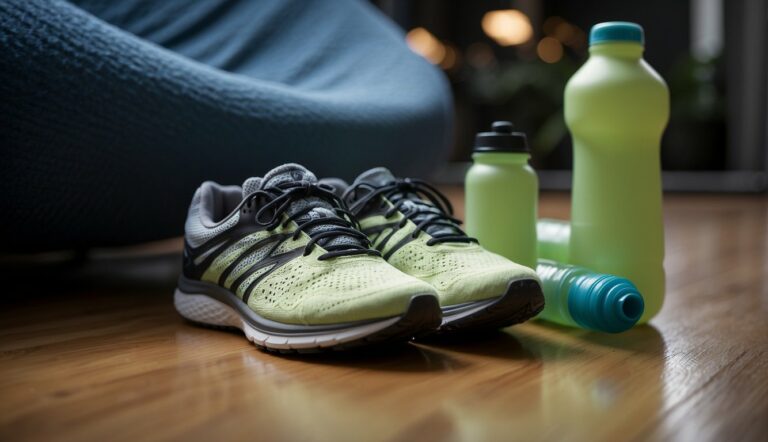Tips for a Quick Post-Run Routine: Efficient Recovery Strategies
As a running coach, I know that a proper post-run routine is crucial for recovery and future performance. It’s not just about cooling down; a good routine can decrease soreness, promote muscle repair, and help maintain consistent training. Including simple yet essential steps can make all the difference without taking up too much time.
Quick and effective, a well-designed post-run routine involves a blend of stretching, replenishment, and tracking progress. By implementing a few key practices, you can enhance your recovery and set yourself up for success on your next run. Let’s optimize those minutes post-run to get the most out of your hard work.
The Basics of a Post-Run Routine
To cap off a successful run and pave the way for optimal recovery, focusing on a gradual cool down and effective rehydration is essential.
Understanding the Importance of Cool Down
Cooling down allows my muscles to transition from intense activity to a state of rest gradually. By continuing to move, such as walking, I help mitigate muscle soreness and stiffness. It’s vital to include gentle stretching after a run; holding each stretch for about 30 seconds to improve flexibility and aid in muscle recovery.
Rehydration Strategies
Immediately after a run, rehydrating is critical to restore fluid balance. I make sure to drink water to quickly address my hydration needs. However, if the run is long or strenuous, I opt for beverages containing electrolytes, as they replenish the salts lost through sweat. It’s not just about the fluids; maintaining a balance between hydrate and rehydrate is crucial for sustained recovery.
Optimizing Your Recovery
To enhance post-run muscle recovery and reduce the risk of injuries, incorporating foam rolling and active recovery into your routine is essential. These methods promote blood flow, help alleviate lactic acid buildup, and support overall performance improvement.
Utilizing Foam Rolling
Foam rolling, a form of self-massage, aids in alleviating muscle tightness and inflammation. By using a foam roller for targeted pressure, you can help your muscles recover more efficiently. Here’s how I integrate foam rolling into my routine:
- Select a foam roller suitable for your needs.
- Spend around 10-20 minutes focusing on major muscle groups.
- Use slow, controlled movements for each muscle.
Key Points:
- Foam rolling post-run can enhance muscle recovery.
- Aim for a moderate pressure that feels like a firm massage.
- Consistency is crucial in reducing the risk of injuries.
Implementing Active Recovery
Active recovery involves low-intensity activities that keep the blood moving, assisting in the clearance of lactic acid, which can contribute to muscle soreness. I recommend the following active recovery strategies:
- A short walk or easy bike ride the day after a hard run.
- Gentle yoga or dynamic stretching to maintain range of motion.
Benefits:
- Helps maintain blood flow and lactic acid removal.
- Supports ongoing performance by minimizing downtime.
By making foam rolling and active recovery a regular part of your post-run routine, you’re taking proactive steps to repair your body and prepare it for your next run. Remember, recovery is as crucial as the run itself for sustaining your running journey.
Nutrition and Refueling

Immediately after a run, it’s crucial to replenish my glycogen stores and kickstart muscle repair. This critical window is when the right nutrition can aid in post-run recovery and prepare me for my next session.
Post-Run Meal Planning
After I finish my run, I plan a meal or snack that combines proteins and carbohydrates within 30 minutes. This helps refuel my body’s depleted glycogen stores efficiently. Here’s a simple guide I follow:
- Carbohydrates: These are necessary to replenish glycogen, which fuels my muscles. I choose quality sources like rice, potatoes, fruits, or whole-grain bread.
- Proteins: Key for muscle repair, and I aim for good sources like Greek yogurt, eggs, or chicken.
Sample Post-Run Meal:
| Component | Examples |
|---|---|
| Protein | Grilled chicken, Greek yogurt, lentils |
| Carbohydrates | Quinoa, whole-grain toast, sweet potato |
| Hydration | Water, electrolyte drink |
I ensure that the meal is balanced and not overly heavy to avoid stomach discomfort.
The Role of Protein and Carbohydrates
Protein is the building block for muscle repair. After a run, my muscles are like a construction site, and proteins act as the workers that rebuild and strengthen the structure. I need about 10-20 grams post-run to start this process.
- Good sources: Eggs, dairy, beans, tofu
Carbohydrates restock my glycogen stores. Since these are the primary source of energy during runs, it’s essential to refill this tank.
- Ratio to aim for: 1:4 protein to carbohydrates
- Best time to eat: Within 30 minutes post-run
By adhering to these guidelines, I set the stage for optimal post-run recovery and prepare my body for the demands of the next workout.
Enhancing Muscle and Tendon Health
Muscle soreness and limited range of motion can hinder your recovery after a run. As a UESCA certified running coach, I’ll guide you through effective techniques to improve your muscle and tendon health.
Stretching for Flexibility
To enhance flexibility and prevent injury, include stretching for all major muscle groups. Focus on static stretches post-run, when muscles are warm. A quad stretch and hamstring stretch can alleviate muscle tightness, while a calf stretch can maintain the elasticity of the Achilles tendon. See the table below for recommended stretches.
| Stretch | Target Muscle | Hold Duration | Notes |
|---|---|---|---|
| Quad Stretch | Quadriceps | 30 Seconds | Ensure balance; avoid knee strain. |
| Hamstring Stretch | Hamstrings | 30 Seconds | Keep spine neutral; stretch gently. |
| Calf Stretch | Calves | 30 Seconds | Press heel down; feel stretch in calf. |
Aim for a pain-free range that improves mobility.
Strength and Conditioning
Regular strength exercises are integral to reinforcing muscle fibers and tendons. A robust core supports your entire body during runs, while a squat targets your quads, hamstrings, and glutes together, mimicking the running motion. Incorporate low-rep, targeted exercises like hip hikes to address IT band and piriformis issues without overwhelming muscles.
Perform each exercise with precision:
- Squat: 5-10 repetitions to build lower body and core strength.
- Hip Hikes: 5-10 repetitions on each side to activate and strengthen hip abductors.
Both exercises promote stability, reduce injury risk, and enhance recovery.
Long-Term Post-Run Practices
Adopting effective long-term post-run practices is pivotal to maximizing your recovery, ensuring consistent performance improvements, and safeguarding your mental health. By valuing sleep and rest, and learning to listen to your body, you can enhance muscle recovery and reduce fatigue over time.
Incorporating Rest and Sleep
Sleep is the cornerstone of muscle repair and restoration. I recommend aiming for 7-9 hours of quality sleep nightly to facilitate bodily repair processes that are critical after running sessions.
-
- Aim for deep, uninterrupted sleep.
- Keep a consistent sleep schedule.
Rest Days:
- Schedule at least one complete rest day per week.
- Use active recovery, such as light walking, if preferred.
Mental Health and Listening to Your Body
Prioritizing your mental health is as important as physical training. Tuning in to your body’s signals of fatigue and stress allows for timely adjustments in your routine.
Mindfulness Techniques:
- Practice meditation or yoga to maintain mental equilibrium.
- Regularly engage in activities that reduce stress and promote well-being.
Body Awareness:
- Acknowledge signs of overtraining such as prolonged fatigue or irritability.
- Adjust your training load and recovery practices based on how you feel physically and mentally.
Incorporating these practices into your routine can lead to sustained improvement and keep you running strong and healthy over the long term.



![Are Stationary Bikes Good for Runners? [Plus 3 Great Recommendations]](https://yournext.run/wp-content/uploads/2022/12/are-stationary-bikes-good-for-runners_featured-768x512.png)


